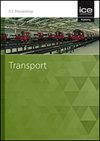从道路交通噪声能量中获取电能--文献综述
IF 1.2
4区 工程技术
Q4 ENGINEERING, CIVIL
Proceedings of the Institution of Civil Engineers-Transport
Pub Date : 2024-02-24
DOI:10.1680/jtran.23.00057
引用次数: 0
摘要
数字技术(包括大数据和物联网概念)的最新发展表明,通过积极主动的资产管理方法,在实现更适当、更有效的路面工程方面大有可为。这可以通过利用先进的传感系统对缺陷进行早期诊断,并根据更精细的数据选择适当的维护策略来实现。这种路面传感系统应包括嵌入式传感器和表面数据传感器(如照相机)的组合,需要电力供应,考虑到全球日益增长的电力需求,这可能是个问题。从路面上收集电力,例如从交通噪音中收集电力(本文的重点),可为实现自给自足、可持续的道路传感系统带来新的希望。如果有效,利用道路交通噪声发电的系统可被计入道路管理部门设定的二氧化碳净零排放目标。文献综述显示,轮胎与路面之间的空气泵送噪声是最具发电潜力的关键噪声源。噪声能量的收集、储存和转换为电能仍处于初步阶段。本文章由计算机程序翻译,如有差异,请以英文原文为准。
Harvesting electricity from road traffic noise energy – a literature review
Recent developments in digital technologies, including big data and internet of things concepts, have shown promising results in achieving more appropriate and effective pavement engineering through a proactive asset management approach. This could be achieved through an early diagnosis of defects and selection of an appropriate maintenance strategy informed by more granular data by the utilisation of advanced sensing systems. Such a sensing system for pavement, which should include a combination of embedded sensors and surface data sensors (e.g. cameras) would require electricity, which could be problematic when considering the growing demand for electricity around the globe. Harvesting electricity from the pavement, for example from traffic noise, which is the focus of this article, could bring new hope for achieving self-efficient and sustainable sensing systems for roads. If effective, an electricity generation system from road traffic noise could be counted towards the net zero carbon dioxide target set by road authorities. A review of the literature revealed that the noise of air pumping between the tyre and the pavement surface is the critical noise source with the highest potential for electricity generation. Harvesting, storage and conversion of noise energy to electrical energy are still in the preliminary stages.
求助全文
通过发布文献求助,成功后即可免费获取论文全文。
去求助
来源期刊
CiteScore
2.60
自引率
0.00%
发文量
42
审稿时长
5 months
期刊介绍:
Transport is essential reading for those needing information on civil engineering developments across all areas of transport. This journal covers all aspects of planning, design, construction, maintenance and project management for the movement of goods and people.
Specific topics covered include: transport planning and policy, construction of infrastructure projects, traffic management, airports and highway pavement maintenance and performance and the economic and environmental aspects of urban and inter-urban transportation systems.

 求助内容:
求助内容: 应助结果提醒方式:
应助结果提醒方式:


